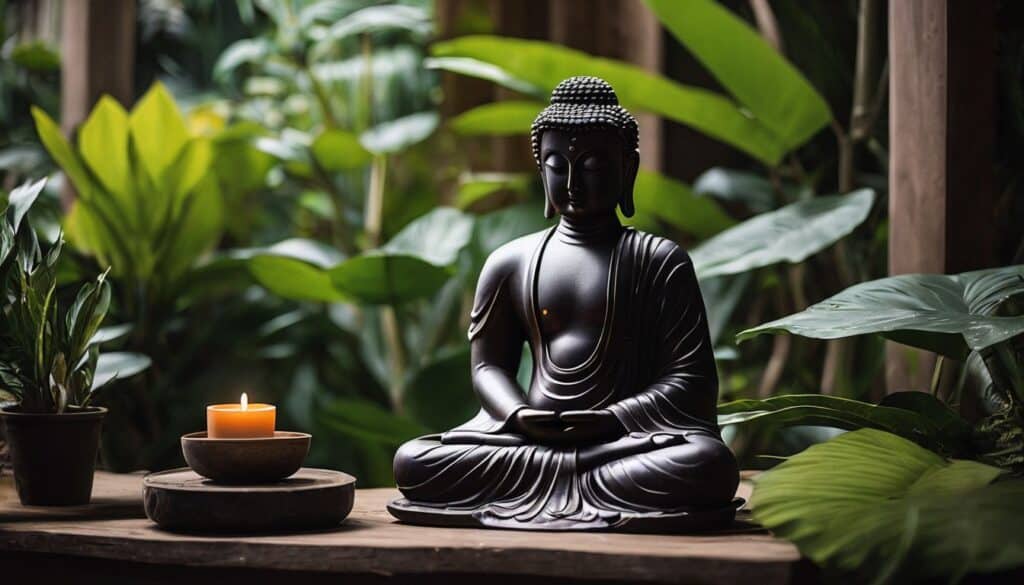Are life’s daily stressors seeming a tad bit too much to handle? I completely understand how you feel. After embarking on my own spiritual journey and deep-diving into various practices, I found that meditation with a spiritual focus can indeed serve as an effective soothing balm.
In this blog post, we will unfold numerous spiritual meditation techniques designed to infuse ultimate relaxation and tranquility into your life. So brace yourself, for it’s time to discover a serene sanctuary amid the tumult!
Key Takeaways
- Spiritual meditation focusing on deep breathing and choosing a point of focus can help achieve ultimate relaxation.
- Incorporating gentle movement or stretching, listening to calming music or nature sounds, and using mantras can enhance the relaxation benefits of spiritual meditation.
- Combining spiritual meditation with mindfulness or gratitude practices can deepen the relaxation experience and cultivate inner peace.
- Mantra meditation is an effective way to relax the mind and find inner peace during spiritual meditation.
How to Begin Your Spiritual Meditation Practice for Relaxation
To start your spiritual meditation practice for relaxation, find a quiet and relaxing space where you won’t be disturbed. Take a moment to settle into a comfortable position, whether sitting on the floor or in a chair with your feet planted firmly on the ground.
Close your eyes and begin by taking deep and intentional breaths, inhaling through your nose, and exhaling slowly through your mouth. Allow yourself to become fully present in the moment, letting go of any thoughts or distractions that arise.
“When meditation is mastered, the mind is unwavering like the flame of a candle in a windless place.” — SuccessConsciousness
Once you have established this foundation of calmness and awareness, choose a focus for your meditation – an object, word, phrase, or even simply observing the sensations of your breath as it goes in and out.
Whatever you choose as your point of focus, allow it to anchor you in the present moment and guide you deeper into relaxation during your meditation practice.
Tip: Make sure you pick a boring item as your focus to meditate on. You don’t want your mind to be engaged by the object.
Finding a quiet and relaxing space
A calm spot is key for good meditation. In this place, there should be no mess and no loud noise. This creates a soft mood that helps you find peace. You can even make a special corner in your room just for this.
All you need to do is sit and close your eyes. Now, you are ready to start with deep breaths!
Starting with deep and intentional breathing
Deep and slow breaths can help you feel calm. You sit or lie down in a quiet place. You take in air through your nose, then let it out slowly through your mouth. This is called deep and intentional breathing.
It helps to reduce stress in your body.
As you breathe in, try to fill your belly with air, not just your chest. This technique is also known as belly breathing and has links with meditation practices that induce relaxation.
By doing this simple act for a few minutes each day, we start our path toward inner peace and spiritual awakening.
Choosing a focus for your meditation
To start your spiritual meditation, find something to focus on. This could be your breath or a word called a “mantra”. Focusing helps you relax and calm the mind. It clears away all other thoughts.
So, as part of your meditation practice, choose what feels best for you. It may be watching your breath go in and out or saying a mantra like ‘peace’ over and over again in your head.
Everyone picks their own path in this journey of calming the body and mind through meditation.
Combining Spiritual Meditation with Other Relaxation Techniques
To enhance the relaxation benefits of spiritual meditation, you can combine it with other techniques such as gentle movement or stretching, listening to calming music or nature sounds, incorporating mindfulness or gratitude practices, and using mantras.
These additional relaxation techniques can help create a more immersive and peaceful experience during your meditation sessions.
“The quieter you become, the more you can hear.” — Anonymous, mentioned on Headspace
Incorporating gentle movement or stretching
Adding gentle movement or stretching to your spiritual meditation practice can enhance relaxation and deepen your mind-body connection. Here are some ways you can incorporate movement into your meditation routine:
- Start with gentle stretches: Begin your meditation session by doing a few simple stretches to loosen up your body. You can try shoulder rolls, neck stretches, or gentle twists to release tension and prepare your body for stillness.
- Practice mindful movement meditation: Combine mindfulness with physical exercise by engaging in mindful movement meditation. This involves performing slow and deliberate movements while staying fully present in the moment. Walking meditation and yoga are excellent examples of mindful movement practices.
- Flow with qigong: Qigong is an ancient Chinese practice that combines gentle flowing movements with deep breathing and visualization. It promotes relaxation, balances energy, and calms the mind. Incorporating qigong into your spiritual meditation routine can help settle thoughts and emotions.
- Dance as a form of meditation: Dancing can be a beautiful way to express yourself and connect with your inner self. Put on some calming music or choose a favorite song that resonates with you, then let go of inhibitions and allow your body to move freely.
Listening to calming music or nature sounds

Listening to calming music or nature sounds can significantly enhance the relaxation and spiritual meditation experience. Music has been proven to have a powerful effect on our emotions and state of mind. Here are some benefits of incorporating music into your spiritual meditation practice:
- Music can shift our mood and help us relax, allowing us to achieve a state of serenity.
- Meditation music can unlock inner tranquility and help us find our inner Zen.
- Relaxing sounds, such as the soothing tones of nature or the peaceful vibrations of instruments like the didgeridoo, can be a holistic and non-invasive therapy for stress management.
- Combining music with meditation can deepen the positive effects of both practices, providing greater stress relief.
- Research has shown that listening to meditation music before engaging in a stressful task can significantly reduce stress levels.
Combining with mindfulness or gratitude practices
When practicing spiritual meditation for relaxation, it can be beneficial to combine it with mindfulness or gratitude practices. Here are some ways you can do that:
- Start your meditation session by taking a few moments to focus on the present moment and bring your attention to your breath.
- As you continue meditation, practice being mindful of any thoughts or emotions that arise without judgment or attachment.
- Incorporate gratitude into your meditation by intentionally bringing to mind things you are grateful for and expressing thanks for them.
- You can also use mantras or affirmations during your meditation to enhance feelings of gratitude and mindfulness.
- Another option is incorporating mindful movement into your meditation practice, such as gentle stretching or walking meditation.
Using Mantras to help relax
Mantra meditation is a great way to relax the mind and find inner peace. Here are some tips for using mantras in your meditation practice:
- Choose a mantra: Select a word, phrase, or affirmation that has a special meaning to you or resonates with your meditation intention. It could be something like “peace,” “love,” or “I am calm and centered.”
- Repeat the mantra: Close your eyes, take a deep breath, and begin silently repeating the mantra to yourself. Focus on the sound and vibration of the words as you say them. Let go of any other thoughts or distractions that arise.
- Set a rhythm: Find a natural rhythm for repeating the mantra, whether it’s saying it with each inhale and exhale or repeating it at a steady pace. Let the repetition become soothing and calming.
- Embrace stillness: As you repeat the mantra, allow yourself to settle into a state of stillness and relaxation. Let go of any tension or stress in your body and mind.
- Stay present: If your mind starts to wander or if thoughts arise, gently bring your attention back to the mantra. Stay present in the here and now, focusing solely on the words and their meaning.
- Practice regularly: Make mantra meditation a regular part of your spiritual practice.by setting aside dedicated time each day to sit quietly and repeat your chosen mantra.
Understanding Spiritual Meditation for Relaxation

Spiritual meditation for relaxation involves a deep connection with oneself and the divine, allowing for inner peace and tranquility. Individuals can experience a profound sense of calmness, clarity, and rejuvenation by engaging in this practice.
Definition and purpose
Spiritual meditation is a practice that focuses on connecting with a higher power or the spiritual aspect of oneself. It involves quieting the mind and releasing thoughts and emotions to achieve a state of relaxation and inner peace.
“Quiet the mind, and the soul will speak.” — Ma Jaya Sati Bhagavati, quoted on Parade
The purpose of spiritual meditation is to unwind from stress, find clarity, and experience a deeper connection with something greater than ourselves. By engaging in this practice, we can cultivate a sense of calmness, tap into our spirituality, and improve our overall well-being.
Spiritual meditation has been found to reduce stress levels and promote mental, emotional, physical, and spiritual health.
Characteristics
Spiritual meditation has several distinct characteristics that set it apart from other forms of meditation. First and foremost, it aims to connect with a higher power or one’s highest self.
This means that the focus is not solely on relaxation or stress reduction but also spiritual growth and awakening. Additionally, spiritual meditation often involves using mantras or repetitive words or phrases to help quiet the mind and deepen concentration.
It also emphasizes observing thoughts and emotions without judgment, allowing them to come and go without attachment. Finally, spiritual meditation incorporates elements of mindfulness, encouraging practitioners to be present in the moment and fully aware of their physical sensations, breath, and surroundings.
Benefits
Meditation offers a range of benefits for our mind, body, and spirit. It can help reduce stress anxiety, and promote better sleep patterns. Spiritual meditation increases our awareness and mindfulness, which leads to personal growth.
It also has positive effects on conditions like high blood pressure, anxiety, and depression. By settling our thoughts and emotions, spiritual meditation helps the body unwind and relax the nervous system.
This can bring us a sense of calmness, peace, and balance while benefiting our emotional well-being and overall health. Regular meditation practice offers numerous benefits that can be explored through different styles of meditation.
Different Types of Spiritual Meditation for Relaxation

In this section, we will explore various types of spiritual meditation that can help you achieve relaxation and inner peace. These techniques include Vipassana meditation, Metta meditation, Mantra meditation, Zazen meditation, Daoist meditation, Gazing meditation, Self-inquiry meditation, Visualization meditation, Kriya Yoga, Sound meditation, and Kundalini meditation.
Each method offers its own unique approach to finding serenity and connecting with your spiritual self.
Vipassana meditation
Vipassana meditation is a form of self-transformation through self-observation. It helps us understand the connection between our mind and body. By practicing Vipassana, we can experience relaxation, mindfulness, and inner peace.
This type of meditation requires a deep focus on our physical sensations and thoughts. It’s a gradual process that takes time, but it allows us to learn ancient teachings and embark on a journey of self-discovery.
Metta meditation
Metta meditation, also known as loving-kindness meditation, is a powerful practice that involves sending out well-wishes and directing them towards ourselves and others. It’s like an ultimate form of selfless love.
This type of meditation has many benefits for our mental, emotional, and physical health. When we engage in metta meditation, our aim is to cultivate compassion and kindness within ourselves towards all beings.
Research suggests this practice can improve our well-being by promoting positive emotions and reducing stress levels. So, if you want to deepen your spiritual journey and enhance your sense of connection with others, metta meditation could be a wonderful addition to your spiritual practice.
Mantra meditation
Mantra meditation is a simple and effective practice that can help you relax and find inner peace. It involves repeating a sound or phrase, called a mantra, to focus your mind and cultivate intention.
Mantra meditation is widely used in Hindu and Buddhist traditions, but it can be practiced by anyone, regardless of their spiritual background. Repeating the mantra can bring your attention away from distracting thoughts and into the present moment.
This practice promotes relaxation and reduces stress by creating a mental state of calmness and clarity. There are many different mantras to choose from, so you can select one that resonates with your goals and intentions for your meditation practice.
Zazen meditation

Zazen meditation is a form of seated meditation that is at the heart of Zen practice. It focuses on the holistic body-mind framework and provides insight into one’s true nature of being.
When practiced by monks, zazen promotes muscle relaxation and slower breathing patterns. It is an open mind-control technique that opens the senses. Zazen has its roots in Buddhist psychology and aims to regulate the mind for spiritual growth and inner peace.
Daoist meditation
There are three types of Daoist meditation: concentrative, insight, and visualization. Concentrative meditation helps quiet the mind and develop focus. Insight meditation involves gaining deep understanding and wisdom through introspection.
Visualization meditation uses imagery to cultivate clarity and intention. Daoist meditation aims to cultivate the Dao (the Way) and achieve a state of wu-wei (effortless action). It can help expand intuition, rejuvenate the body, and cultivate qi (life energy).
Practicing these techniques can bring balance, tranquility, and spiritual growth to your life.
Gazing meditation
Gazing meditation is a type of spiritual meditation that involves focusing your gaze on a specific object, such as a candle flame or a picture. By fixating your eyes on the object, you can help calm your mind and increase your ability to concentrate.
This practice is believed to sharpen attention and improve cognitive performance. Candle gazing, in particular, is known for its calming effects and its ability to promote relaxation and inner peace.
It’s a simple yet powerful technique that can be incorporated into your spiritual meditation practice for ultimate relaxation.
Self-inquiry meditation
Self-inquiry meditation is a practice that involves turning inward and asking the question “Who am I?” without any expectations. It focuses on connecting with the heart and staying present in the moment.
Through self-reflection, individuals can explore their true selves and better understand themselves. This type of meditation helps to anchor focus and awareness by using spiritual questions as a guide.
To practice self-inquiry meditation, it is important to be aware of your surroundings, observe your body, thoughts, and breath, relax completely, and maintain a calm state of mind.
Visualization meditation
Visualization meditation is a technique that helps us relax and find spiritual enlightenment. By using our minds, we can influence our bodies and experience deep relaxation. This type of meditation can be especially helpful for people who struggle with anxiety, stress, or high blood pressure.
It allows us to ease tension in our muscles and promote a sense of calmness and well-being. Through visualization meditation, we can tap into our inner power and create positive changes within ourselves.
Kriya Yoga
Kriya Yoga is a powerful and sacred practice of advanced meditation techniques. It goes beyond relaxation and helps us realize our connection with God and liberate our souls. Sudarshan Kriya Yoga, in particular, is a recommended breathing technique that can be used for relaxation, stress management, and improving organ function.
Kriya Yoga focuses on energy and breath control, known as pranayama. By using specific breathing and spine techniques, we can unlock deep states of awareness, achieve self-realization, and experience spiritual growth.
Kriya Yoga is just one part of a comprehensive spiritual path that includes various meditation techniques to help us connect with ourselves in profound ways.
Sound meditation
Sound meditation is a powerful technique that uses sound vibrations to help you relax your body and mind. It is considered one of the best methods for achieving a state of serenity.
By focusing on soothing sounds, such as nature sounds or calming music, you can quiet your thoughts and let go of stress and tension. Sound meditation allows you to immerse yourself in the healing frequencies of sound vibrations, which can promote deep relaxation, reduce anxiety, and enhance overall well-being.
This practice is perfect for those seeking a spiritual experience while also enjoying the benefits of relaxation.
Kundalini meditation
Kundalini meditation is a practice that focuses on awakening your spiritual potential. It doesn’t rely on specific breathing techniques or postures, making it accessible to everyone.
This type of meditation brings more awareness and intention to your daily life. It has been reported in traditional spiritual literature to have profound experiences. Kundalini meditation may be beneficial for conditions associated with high stress, such as cardiovascular disease and insomnia.
If you’re interested in exploring Kundalini energy, Ananda offers guidance and support through experienced meditation instructors.
Maintaining Your Spiritual Meditation Practice
Consistency and commitment are essential to maintaining your spiritual meditation practice. Setting aside dedicated time each day for meditation, even just a few minutes is important.
By making it a regular part of your routine, you can reinforce the habit and ensure that you continue to reap the benefits of spiritual meditation.
Distractions are inevitable, but learning how to deal with them is crucial. When distractions arise during meditation, acknowledge them without judgment and gently bring your focus back to your breath or chosen focal point.
Over time, this will help develop greater concentration and control over the mind.
It’s also essential to adjust your techniques as needed. Different methods may resonate with you at different times, so don’t be afraid to explore various approaches until you find what works best for you.
Additionally, listen to your body and adapt your practice based on any physical limitations or discomfort that may arise.
To deepen your spiritual meditation experience further, consider setting intentions or affirmations before each session. This.
Consistency and commitment
Consistency is important for meditation to have a lasting impact on the mind. I understand that it can be challenging to maintain consistency in your meditation practice, especially with a busy lifestyle. However, it is crucial to make an effort and commit to regular meditation sessions. Here are some tips to help you stay consistent:
- Set aside dedicated time for meditation each day, even if it’s just for a few minutes.
- Find a quiet and relaxing space where you can meditate without distractions.
- Make it a part of your daily routine, just like brushing your teeth or taking a shower.
- Start with shorter sessions and gradually increase the duration as you become more comfortable.
- Use reminders or alarms to prompt you to meditate simultaneously each day.
- Find accountability partners or join meditation groups to stay motivated and accountable.
- Be flexible and adapt your practice based on your schedule. It’s better to have a short session than to skip it altogether.
- Remember that consistency is more important than perfection. Even if you miss a day, get back on track the next day.
Dealing with distractions
Distractions can be helpful in meditation. Instead of seeing them as obstacles, embrace them and use them to deepen your practice. Here are some tips for dealing with distractions:
- Acknowledge the distraction: When you notice your mind wandering or getting caught up in thoughts, simply acknowledge it without judgment.
- Let it go: Once you’ve acknowledged the distraction, gently let it go and bring your focus back to your breath or chosen meditation object.
- Refocus your attention: If a distraction persists, try redirecting your attention back to the present moment by focusing on the physical sensations of your body or the sounds around you.
- Practice acceptance: Remember that distractions are a natural part of meditation. Instead of getting frustrated or discouraged, practice accepting them and returning your attention each time.
- Use visualization techniques: If you struggle with persistent thoughts or emotions, visualize them as clouds passing by in the sky or leaves floating down a river. This can help create distance and perspective from these distractions.
- Experiment with different techniques: If one method of dealing with distractions doesn’t work for you, don’t give up! Explore other techniques like mantra repetition or guided meditations to see what resonates with you.
Adjusting techniques to fit your needs
When it comes to spiritual meditation, it’s important to find techniques that work for you. Here are some ways you can adjust your meditation practice to suit your needs better:
- Experiment with different techniques: Don’t be afraid to try different types of meditation to see what resonates with you the most. Whether it’s Vipassana, metta, mantra, or visualization meditation, explore and find the one that brings you peace and relaxation.
- Consult with a spiritual mentor or guide: If you’re unsure about which technique to choose or how to customize your practice, seeking guidance from a spiritual mentor or guide can be helpful. They can provide insights and suggestions based on their experience and knowledge.
- Be consistent and committed: Consistency is key in any meditation practice. Set aside regular time each day for your spiritual meditation. Make it a priority and commit yourself to the practice.
- Deal with distractions: It’s natural for distractions to arise during meditation. Instead of fighting them or getting frustrated, acknowledge their presence and gently bring your attention back to your chosen focus – whether it’s your breath, a mantra, or an object of visualization.
- Adjust techniques to fit your needs: Feel free to modify the techniques according to what works best for you. For example, if sitting cross-legged is uncomfortable, sit on a chair instead. If focusing solely on your breath feels challenging, incorporate other focal points like sounds or sensations in your body.
Tips for Deepening Your Spiritual Meditation Experience
One way to deepen your spiritual meditation experience is by setting intentions or affirmations before you begin. This helps guide your practice and allows you to focus on specific aspects of your life or personal growth.
Additionally, practicing gratitude and letting go of negative emotions during meditation can enhance overall relaxation and spiritual benefits. Creating a sacred space dedicated solely to meditation can also help create a peaceful environment that fosters deep introspection and connection with the divine.
Setting intentions or affirmations
Setting intentions or affirmations is a powerful way to enhance your spiritual meditation experience. Here are some tips on how to do it:
- Begin by finding a quiet and comfortable space to meditate without distractions.
- Close your eyes and take a few deep breaths to relax your body and mind.
- Set an intention for your meditation session. This can be something you want to focus on or manifest in your life, such as peace, love, or abundance.
- Repeat positive affirmations silently or out loud. These statements affirm what you want to create or attract into your life. For example, “I am worthy of love and happiness” or “I am open to receiving abundance in all areas of my life.”
- Visualize yourself already experiencing what you desire. See it in vivid detail and feel the emotions associated with it.
- Stay present in the moment and allow any thoughts or emotions to come and go without judgment.
- End your meditation by expressing gratitude for the intention you set and the progress you’re making on your spiritual journey.
Practicing gratitude and letting go of negative emotions
Practicing gratitude and releasing negative emotions are essential aspects of spiritual meditation. Here are some ways to incorporate these practices into your meditation routine:
- Take a few moments before meditating to reflect on things you are grateful for. This can help shift your focus towards positive thoughts and increase feelings of happiness and contentment.
- During your meditation, when negative thoughts or emotions arise, acknowledge them without judgment and then let them go. Observing and releasing negative emotions can help cultivate inner peace and emotional well-being.
- Incorporate affirmations or positive statements into your meditation practice. Repeat phrases like “I am grateful” or “I let go of negativity” to reinforce feelings of gratitude and release negative energy.
- During meditation, visualize yourself surrounded by love, light, and positive energy. Imagine any negativity dissipating and being replaced by feelings of gratitude, joy, and relaxation.
Creating a sacred space for meditation
Creating a sacred space for meditation is important if you want to live a healthier and happier life. Here are some tips on how to create your own sacred space:
- Find a quiet and peaceful area in your home where you can meditate without distractions.
- Clear the space of any clutter or unnecessary items. The goal is to create a clean and serene environment.
- Use candles, incense, or essential oils to create a soothing atmosphere and promote relaxation.
- Consider adding meaningful objects such as statues, crystals, or symbols that hold spiritual significance for you.
- Choose comfortable seating or cushioning to ensure you can sit comfortably during your meditation practice.
- Control the lighting in the room by using dimmers, curtains, or blinds to create an ambiance that suits your preferences.
- Play gentle music or nature sounds in the background to enhance the calming effect of your sacred space.
- Consider incorporating natural elements into your space, such as plants or a small indoor fountain, to bring a sense of tranquility and connection with nature.
- Keep your sacred space clean and organized regularly to maintain its positive energy.
Examples of Spiritual Meditation Methods
Let’s explore some examples of spiritual meditation methods that you can try. One popular method is Vipassana meditation, which involves observing your thoughts and sensations without judgment.
Another method is Metta meditation, also known as loving-kindness meditation, where you focus on sending love and compassion to yourself and others. Mantra meditation uses repetitive words or phrases to bring focus and calm the mind.
Zazen meditation, rooted in Zen Buddhism, emphasizes sitting still and observing the breath without attachment to thoughts. Daoist meditation combines movement with breath control to cultivate energy flow within the body.
Gazing meditation involves focusing on an object or a candle flame to enhance concentration. Self-inquiry meditation encourages self-reflection and exploring the nature of consciousness.
Visualization meditation uses guided imagery to create a peaceful mental landscape. Kriya Yoga incorporates breathing techniques and movements for spiritual purification. Sound meditation utilizes soothing sounds like singing bowls or chanting for relaxation and inner peace.
Remember, these are just a few examples of spiritual meditation methods available to you! Feel free to experiment with different techniques until you find one that resonates with your needs and preferences.
Choosing the Right Spiritual Meditation Method for You
When it comes to choosing the right spiritual meditation method for you, it’s important to experiment with different techniques and find what resonates with your personal preferences and needs.
Consultation with a spiritual mentor or guide can also provide valuable insight and guidance in selecting the most suitable practice that aligns with your spiritual journey. Remember, meditation is a deeply personal experience, so trust your intuition and find the method that brings you inner peace and spiritual growth.
Experimenting with different techniques
When it comes to spiritual meditation, it’s important to find the technique that works best for you. Here are some tips for experimenting with different techniques:
- Start with mindfulness meditation: This is a popular technique that involves focusing on the present moment and observing your thoughts and sensations without judgment.
- Try transcendental meditation: This method uses a mantra, a word or phrase repeated silently, to help quiet the mind and achieve a state of deep relaxation.
- Explore body scan meditation: This practice involves systematically scanning your body from head to toe and paying attention to any sensations or areas of tension.
- Consider loving-kindness meditation: This technique involves sending feelings of love, kindness, and compassion towards yourself and others.
- Experiment with movement meditation: Incorporate gentle movements like yoga or tai chi into your meditation practice to bring mindfulness to your body and promote relaxation.
- Practice focused meditation: Choose an object or concept to focus your attention on, such as a candle flame or the sensation of your breath entering and leaving your body.
- Try guided meditations: Use pre-recorded or live guided meditations that provide instructions and visualizations to help guide you through the practice.
- Explore visualization techniques: Picture yourself in a peaceful setting or imagine positive outcomes in order to create a sense of calm and relaxation.
- Engage in nature-based meditations: Spend time in natural surroundings, such as forests or beaches, and let the sights, sounds, and smells deepen your meditative experience.
Consulting with a spiritual mentor or guide
Finding a spiritual mentor or guide can significantly benefit your journey in choosing the right spiritual meditation method. They have knowledge and experience in different techniques and can provide guidance tailored to your needs and goals.
A mentor or guide can help you explore various practices, answer your questions, and offer support. Their expertise will ensure that you are on the right path and practicing meditation in a way that aligns with your beliefs and aspirations.
So don’t hesitate to seek their advice as you embark on this transformative journey of spiritual meditation for ultimate relaxation.
Conclusion on Spiritual Meditation Methods For Relaxation
In conclusion, exploring spiritual meditation methods can significantly enhance your relaxation experience. By finding a quiet space, practicing deep breathing, and choosing a focus for your meditation, you can begin your journey toward ultimate relaxation.
Additionally, incorporating other techniques such as gentle movement or stretching, listening to calming sounds, and using mantras can further deepen the benefits of spiritual meditation.
Remember to maintain consistency in your practice and adjust techniques to fit your needs. With dedication and commitment, you can unlock the amazing potential of spiritual meditation for relaxation and overall well-being.
FAQ on Spiritual Meditation Methods For Relaxation
Q: What is mindfulness meditation and how can a beginner practice it?
A: Mindfulness meditation is a type of meditation where you focus on your breath and observe your thoughts and emotions without judgment. As a beginner, you can practice this by setting aside a few minutes of meditation each day in a quiet place. Close your eyes, take deep breaths and pay attention to your breath flowing through your body. Remember, there’s no wrong way to meditate, the key is to practice regularly and maintain a non-judgemental attitude.
Q: How can guided meditation help in achieving relaxation?
A: Guided meditation can help in achieving relaxation by offering an element of structure in the meditation process. This type of meditation involves following along with a guide or instructor, either in person or through a meditation app. They will lead you through a series of calming visualizations and prompts focusing on the breath to help you connect, reflect and unwind.
Q: What is transcendental meditation, and what distinguishes it from other types of meditation?
A: Transcendental meditation is a specific form of silent mantra meditation. It differs from other types of meditation as it doesn’t involve focusing on the breath or contemplation but rather encourages a restful state of mind beyond thinking. A mantra, a specific sound or phrase given by a trained practitioner, is silently repeated to facilitate transcendental experiences and spiritual awakening.
Q: Can you explain the concept of loving kindness meditation?
A: Loving kindness meditation, also known as Metta meditation, is a practice intended to develop goodwill and kindness towards oneself and others. This type of meditation involves systematically focusing on sending feelings of warmth, love, and care first to oneself, then to others, and finally towards everyone universally. This practice is beneficial for emotional healing, cultivating compassion and developing a positive outlook towards life.
Q: What are the main types of meditation practices and how does each type benefit us?
A: There are many types, but the major categories of meditation practices are Mindfulness, Transcendental, Loving Kindness, and Chakra meditation. While mindfulness helps us connect with our thoughts and emotions non-judgmentally, transcendental meditation aims for spiritual awakening. Loving kindness meditation enhances our capacity for forgiveness, self-compassion, and love. Chakra meditation, on the other hand, focuses on the different energy centres in our body, aiming to balance our physical, emotional, and spiritual self.
Q: What are the proven benefits of meditation backed by systematic reviews and meta-analysis?
A: The benefits of meditation are extensive and some of the notable ones include reduction of stress and anxiety, improved concentration and mindfulness, enhanced self-awareness and self-esteem, better sleep, pain reduction, and lowered blood pressure. These benefits are not mere hearsay but backed by numerous systematic reviews and meta-analysis in scientific literature. Regular practice of different meditation styles can bring about these positive changes over time.
Q: How can we develop a daily meditation routine?
A: You can make meditation a daily habit by setting a specific time each day to meditate, it can be morning meditation or whenever you feel relaxed. Start with a few minutes of meditation and gradually increase the duration. Find a quiet and comfortable space where you can meditate without interruptions. Guided meditation apps can be useful for beginners. The important aspect is consistency. Try to practice daily, even if it’s for a small amount of time.
Q: How does focusing on your breath during meditation help?
A: Focusing on the breath is a fundamental part of many meditation techniques. It serves as an anchor point for your attention. Whenever your mind starts to wander, you bring it back by focusing on your breath. This process trains your mind to improve its attention span, reduce random thoughts and remain in the present moment. It can play a key role in achieving relaxation and serenity.
Q: What is chakra meditation and how it can be done?
A: Chakra meditation refers to practices utilising various spiritual traditions to influence the energy centers known as chakras in the body. The technique involves focusing on these chakras, visualising their color, location and qualities, and using breath or mantras to activate and balance them. This form of meditation can have profound spiritual benefits of meditation and widely believed to promote physical, mental and emotional healing.
Q: What are the spiritual benefits of meditation?
A: Meditation has several spiritual benefits. It empowers you on the journey of self-discovery helping you understand your true nature beyond physical existence. Regular practice of meditation can spark a spiritual awakening, giving you a sense of connectedness and peace. It can assist in understanding and managing your thoughts and emotions better, contributing to the overall spiritual health. Many people also report experiences of heightened intuition and enhanced empathy through regular meditation.





Leave a Reply